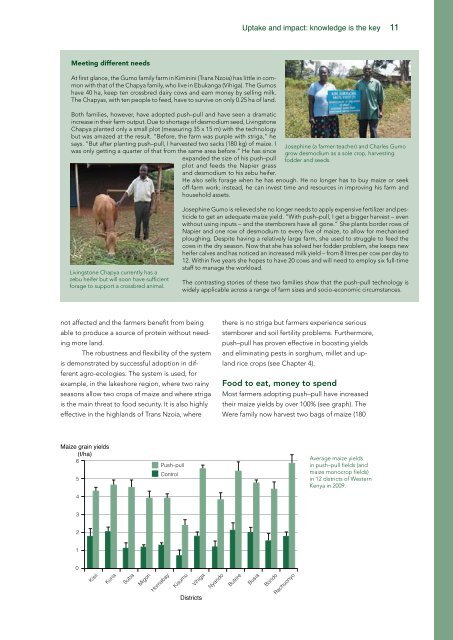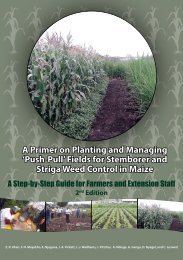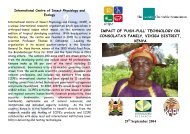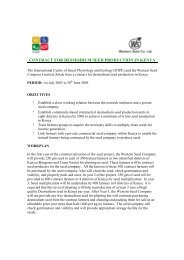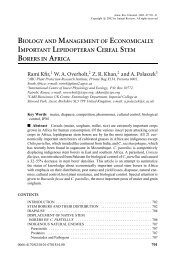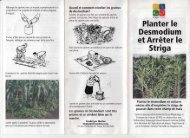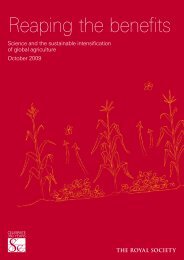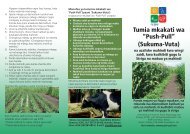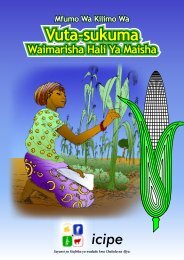a model for Africa's green revolution - Push-Pull
a model for Africa's green revolution - Push-Pull
a model for Africa's green revolution - Push-Pull
Create successful ePaper yourself
Turn your PDF publications into a flip-book with our unique Google optimized e-Paper software.
Uptake and impact: knowledge is the key 11<br />
Meeting different needs<br />
At first glance, the Gumo family farm in Kiminini (Trans Nzoia) has little in common<br />
with that of the Chapya family, who live in Ebukanga (Vihiga). The Gumos<br />
have 40 ha, keep ten crossbred dairy cows and earn money by selling milk.<br />
The Chapyas, with ten people to feed, have to survive on only 0.25 ha of land.<br />
Both families, however, have adopted push–pull and have seen a dramatic<br />
increase in their farm output. Due to shortage of desmodium seed, Livingstone<br />
Chapya planted only a small plot (measuring 35 x 15 m) with the technology<br />
but was amazed at the result. “Be<strong>for</strong>e, the farm was purple with striga,” he<br />
says. “But after planting push–pull, I harvested two sacks (180 kg) of maize. I<br />
was only getting a quarter of that from the same area be<strong>for</strong>e.” He has since<br />
expanded the size of his push–pull<br />
plot and feeds the Napier grass<br />
and desmodium to his zebu heifer.<br />
Josephine (a farmer-teacher) and Charles Gumo<br />
grow desmodium as a sole crop, harvesting<br />
fodder and seeds.<br />
He also sells <strong>for</strong>age when he has enough. He no longer has to buy maize or seek<br />
off-farm work; instead, he can invest time and resources in improving his farm and<br />
household assets.<br />
Livingstone Chapya currently has a<br />
zebu heifer but will soon have sufficient<br />
<strong>for</strong>age to support a crossbred animal.<br />
Josephine Gumo is relieved she no longer needs to apply expensive fertilizer and pesticide<br />
to get an adequate maize yield. “With push–pull, I get a bigger harvest – even<br />
without using inputs – and the stemborers have all gone.” She plants border rows of<br />
Napier and one row of desmodium to every five of maize, to allow <strong>for</strong> mechanised<br />
ploughing. Despite having a relatively large farm, she used to struggle to feed the<br />
cows in the dry season. Now that she has solved her fodder problem, she keeps new<br />
heifer calves and has noticed an increased milk yield – from 8 litres per cow per day to<br />
12. Within five years she hopes to have 20 cows and will need to employ six full-time<br />
staff to manage the workload.<br />
The contrasting stories of these two families show that the push–pull technology is<br />
widely applicable across a range of farm sizes and socio-economic circumstances.<br />
not affected and the farmers benefit from being<br />
able to produce a source of protein without needing<br />
more land.<br />
The robustness and flexibility of the system<br />
is demonstrated by successful adoption in different<br />
agro-ecologies. The system is used, <strong>for</strong><br />
example, in the lakeshore region, where two rainy<br />
seasons allow two crops of maize and where striga<br />
is the main threat to food security. It is also highly<br />
effective in the highlands of Trans Nzoia, where<br />
there is no striga but farmers experience serious<br />
stemborer and soil fertility problems. Furthermore,<br />
push–pull has proven effective in boosting yields<br />
and eliminating pests in sorghum, millet and upland<br />
rice crops (see Chapter 4).<br />
Food to eat, money to spend<br />
Most farmers adopting push–pull have increased<br />
their maize yields by over 100% (see graph). The<br />
Were family now harvest two bags of maize (180<br />
Maize grain yields<br />
(t/ha)<br />
6<br />
5<br />
4<br />
<strong>Push</strong>–pull<br />
Control<br />
Average maize yields<br />
in push–pull fields (and<br />
maize monocrop fields)<br />
in 12 districts of Western<br />
Kenya in 2009.<br />
3<br />
2<br />
1<br />
0<br />
Kisii<br />
Kuria<br />
Suba<br />
Migori<br />
Homabay<br />
Kisumu<br />
Vihiga<br />
Districts<br />
Nyando<br />
Butere<br />
Busia<br />
Bondo<br />
Rachuonyo


